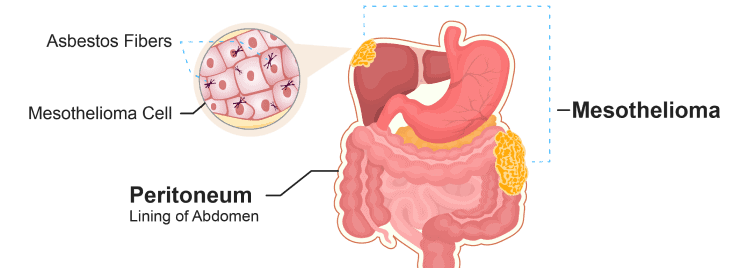Peritoneal mesothelioma is a malignancy that develops in the peritoneum, which is the lining of the abdomen. The most effective treatment for this kind of mesothelioma is surgery with hot chemotherapy, which frequently extends life expectancy to five years or beyond.
10 to 30 percent of all malignant mesotheliomas originate in the peritoneum. In France, the incidence is roughly 1/500,000 per year, while in other regions of Europe it approaches 1/200,000 per year (Italy). Predominantly men are afflicted.
Symptoms of peritoneal mesothelioma
At the time of presentation, clinical symptoms may include abdominal discomfort, abdominal mass, increased abdominal circumference, abdominal distention, ascites (fluid in the belly), fever, weight loss, exhaustion, anemia, and digestive difficulties. Some individuals experience a number of months of non-specific symptoms prior to receiving a definitive diagnosis. In some instances, peritoneal mesothelioma is discovered inadvertently when a patient seeks treatment for an unrelated condition, such as gallbladder, hernia, or pelvic tumor.
According to experienced physicians, patients often exhibit symptoms for six to two years prior to diagnosis. When a patient visits a physician, the patient, the patient’s family, and the physician typically suspect that something else is wrong. Men commonly present with an inguinal hernia (a bulge in the groin) or an umbilical hernia as their initial symptom (bulge around the belly button.) The discovery of a tumor mass during a pelvic examination is the first sign of a problem for some women.
Symptoms of advanced peritoneal mesothelioma include intestinal blockage and an increased propensity for blood clotting. Blood tests reveal an elevated platelet count in fifty percent of peritoneal patients; however, this is of limited diagnostic use because it can be caused by so many diseases. Additionally, anemia and low albumin levels are present.

Peritoneal mesothelioma causes
- Mesothelioma is almost invariably caused by asbestos exposure, a group of minerals composed of small fibers that were frequently employed in construction.
- These microscopic fibers can readily become lodged in the lungs, causing progressive lung damage.
- It normally takes more than 20 years after asbestos exposure for mesothelioma to develop, causing mesothelioma to produce noticeable issues.
- Asbestos was entirely outlawed in 1999, thus the risk of exposure is now very lower. But materials containing asbestos are still found in many older buildings.
How peritoneal mesothelioma is diagnosed?
The diagnosis of peritoneal mesothelioma often begins with an x-ray. CT scans and MRIs are utilized less frequently. On a CT scan or MRI, doctors can easily mistake mesothelioma for an abundance of gas, leading to a misdiagnosis.
To confirm a peritoneal mesothelioma diagnosis, doctors will likely conduct a diagnostic test called a peritoneoscopy. During this operation, a surgeon inserts a small camera into the patient’s belly through a small incision. The camera assists the surgeon in locating and removing a tissue sample from the abdominal mesothelioma tumor.
The surgeon sends the tissue sample to a laboratory where it is examined by a pathologist. Pathologists are physicians that specialize in identifying various diseases. The sample must be sent to a pathologist since peritoneal mesothelioma resembles other malignancies, even at the cellular level. To ensure that the suspected peritoneal mesothelioma diagnosis is accurate, pathologists conduct numerous tests on the tumor material.
Why do women have a higher risk of developing peritoneal mesothelioma?
Men account for the majority of both pleural and peritoneal mesothelioma cases. However, peritoneal mesothelioma is diagnosed in more women than pleural mesothelioma. Due to their predominance in asbestos-containing workplaces, men are at greater risk.
The majority of instances of multicystic and well-differentiated peritoneal mesothelioma occur in young women. Fibromatosis, a benign growth that affects women, maybe a contributing factor, but experts do not know why.
The good news is that these kinds of peritoneal mesothelioma are not aggressive and seldom metastasis in women. Frequently, surgery is curative.
Treatment
In the past, peritoneal mesothelioma was treated similarly to pleural mesothelioma. In actuality, there are no precise cancer therapy guidelines for peritoneal mesothelioma. Numerous individuals have cytoreductive surgery, followed by hyperthermic intraoperative peritoneal perfusion with chemotherapy (HIPEC), a treatment in which heated chemotherapy is delivered into the abdomen. When surgery is not curative, platinum chemotherapy is the standard of care, occasionally followed by second or third-line chemotherapy if necessary.
Prognosis
- Although it is known that mesothelioma has a terrible prognosis, peritoneal mesothelioma has the greatest prognosis among all kinds of this illness.
- This might vary dependent on a variety of prognostic factors, including a patient’s overall health, cell type, cancer spread, and available treatment options, among others.
- A patient in good general health, for instance, will be able to withstand more harsh treatment alternatives to eradicate peritoneal mesothelioma cancer cells.
- Mesothelioma contains three cell kinds that have a significant impact on a patient’s prognosis. Epithelioid cells make up 75 to 90 percent of peritoneal mesothelioma patients and are typically easier to treat than sarcomatoid or biphasic cells. A patient with epithelial peritoneal mesothelioma will likely have a more favorable prognosis and longer survival time than those with sarcomatoid or biphasic cells.
If you want to know about pleural mesothelioma then visit this link: https://costamedic.com/mesothelioma/



